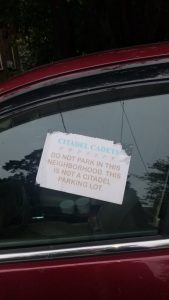 By Brett Wood CAPP, PE
By Brett Wood CAPP, PE
The weather outside is starting to change, ushering in cooler and more palatable temperatures. That’s usually a sign that students are heading back to college and my favorite sport (college football) is about to kick off. While these things are happening, it’s obviously a slightly different take in 2020. Some students are finding their way back to campus, with either in-person, online, or hybrid classes awaiting them. But for those campuses that are occupied, one other thing comes along with the student—their car.
One of the most common stakeholder complaints I hear around academic campuses is spillover student parking in adjacent residential neighborhoods. For the past two years, I’ve been living within two blocks of an academic campus. I can now confirm firsthand what all of those stakeholders have mentioned. The students and their cars invade and stay for days, weeks, and sometimes months on end. A lot of my neighbors are aggrieved by it, going as far to post notes and messages on the cars. It’s all a fascinating observational experiment that directly ties back to the work we do!
There are several considerations in this type of situation:
- Do nothing and hope that the demand for parking finds balance or equilibrium.
- Implement a neighborhood parking permit program that restricts parking to only registered vehicles. This requires residents to register all vehicles that will park on street and likely pay an annual permit fee. And it introduces parking enforcement in an area that isn’t used to it.
- Implement time limits for parking for non-registered vehicles to dis-incentivize long stays (based in hours or days). This allows parking but prohibits vehicle storage.
- Implement paid parking with the permit program to allow for unregistered vehicles to pay for their time. A great example of this is occurring in Columbus, Ohio, near the Ohio State University campus. Revenues collected from non-registered vehicles is also reinvested into the area to help improve congestion and mobility.
There’s no easy solution to the problem. The one surefire way to find equitable solutions is collaboration where the community and campus leadership work together to define the problem and develop a response. By working together, the outcomes tend to focus on efficient use of space and minimization of conflicts, rather than choosing one side over the other.
Brett Wood, CAPP, PE, is president of Wood Solutions Group, LLC.
